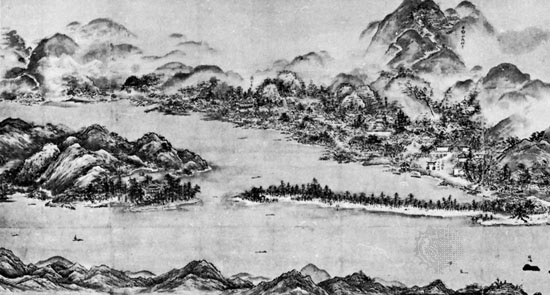suiboku-ga
Japanese painting style
also called Sumi-e,
 Japanese monochrome ink painting, a technique first developed in China during the Sung dynasty (960–1274) and taken to Japan by Zen Buddhist monks in the mid-14th century. Although generally content to copy Chinese models, early Japanese artists also excelled in the field of portraiture and figure painting. Suiboku-ga reached its height in the Muromachi period (1338–1573) with such masters as Sesshū Tōyō, whose landscapes were uniquely Japanese, and Sesson Shūkei, who worked in the far northeast of Japan.
Japanese monochrome ink painting, a technique first developed in China during the Sung dynasty (960–1274) and taken to Japan by Zen Buddhist monks in the mid-14th century. Although generally content to copy Chinese models, early Japanese artists also excelled in the field of portraiture and figure painting. Suiboku-ga reached its height in the Muromachi period (1338–1573) with such masters as Sesshū Tōyō, whose landscapes were uniquely Japanese, and Sesson Shūkei, who worked in the far northeast of Japan.The bold use of black ink strokes and washes allowed suiboku-ga artists to eliminate from their paintings all but the essential character of their subject, an aim closely related to the pursuit of Zen Buddhism. Although suiboku-ga was popular well into the Tokugawa period (1603–1867), it soon lost its spontaneity and became formalistic in style.
- Lyme Regis
- Lymon, Frankie, and the Teenagers
- lymph
- lymphatic system
- lymphedema
- lymph node
- lymph nodule
- lymphoblast
- lymphocyte
- lymphocytic choriomeningitis
- lymphogranuloma venereum
- lymphoid tissue
- lymphoma
- Lynch, Benito
- Lynchburg
- lynching
- Lynch, Jack
- Lynch, John R
- Lyndon Baines Johnson: Inaugural Address
- Lyndon B. Johnson
- Lyndon B. Johnson: The Great Society
- Lyndon B. Johnson: The War on Poverty
- Lynd, Robert; and Lynd, Helen
- Lyndsay, Sir David
- Lynen, Feodor